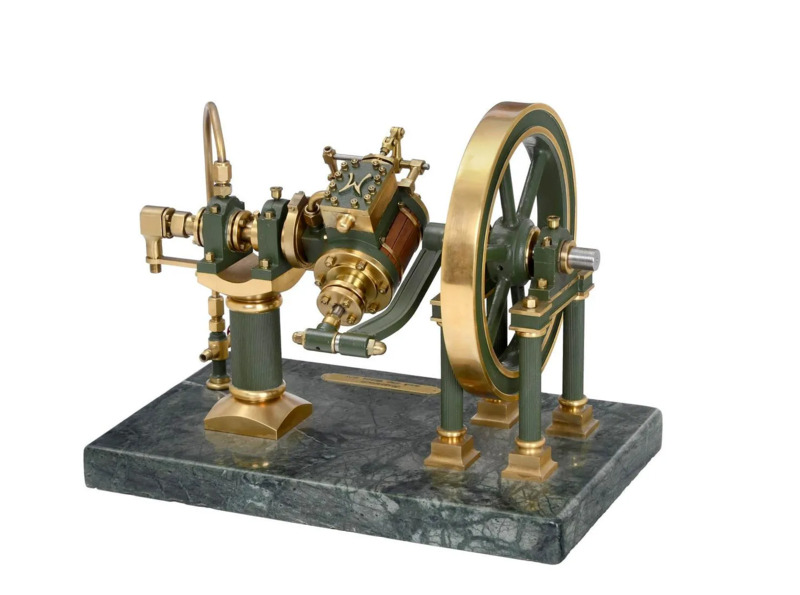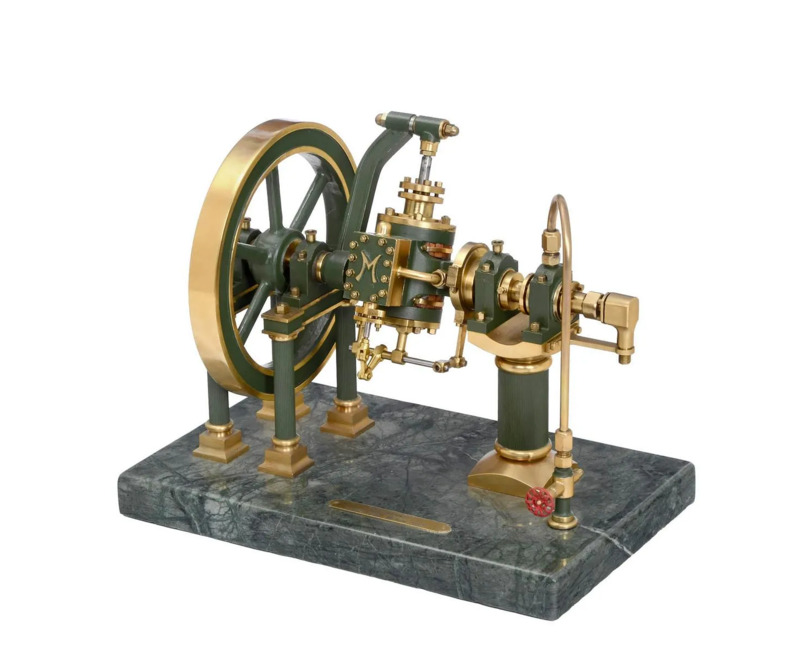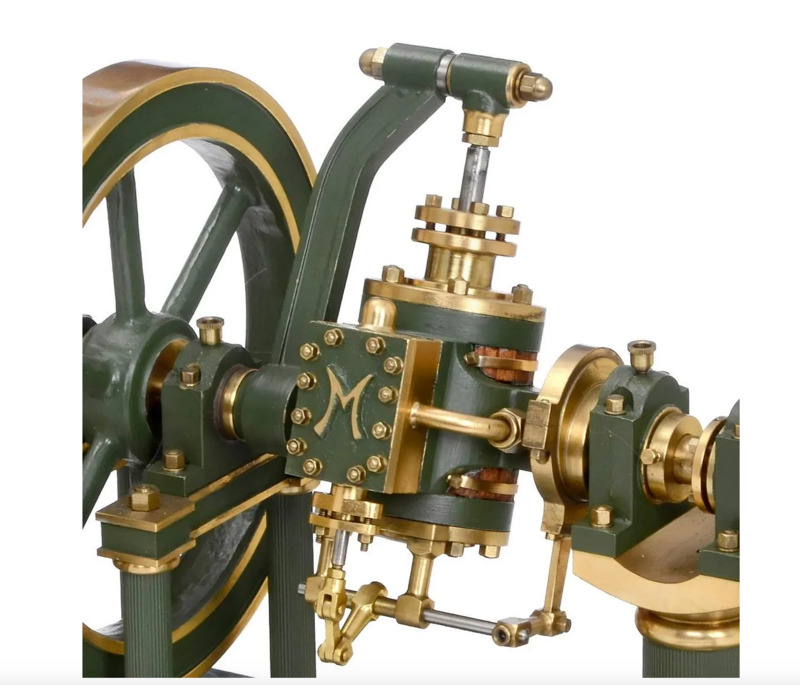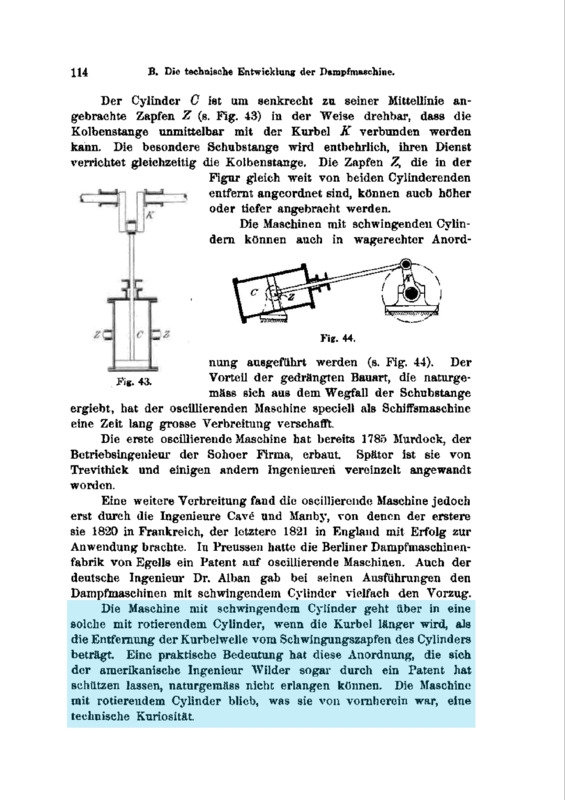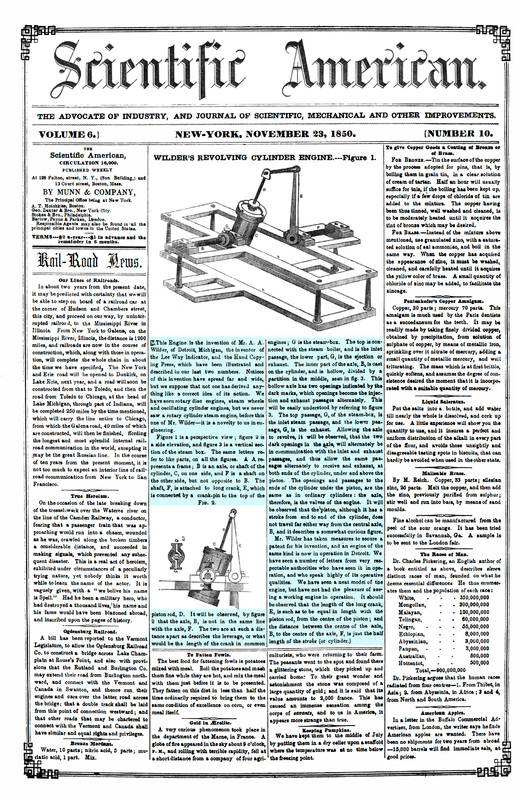Wilder Revolving Cylinder Steam Engine Model
Working Model of a Wilder Revolving Cylinder Steam Engine
Little is known about this particular model or the name of the model builder. Additional research is needed. VTM suspects that origin date of 1825 is incorrect.
"After the original from 1825, with rotating cylinder, all-brass construction, partially green-lacquered, wood-planked cylinder, 1 ½ in., slide-valve control with eccentric ring, spoked flywheel, 5 1/3 in., on marble base, 9 ½ x 6 in."
Similar Models
Two similar models have been built by Ernst Eyle, of Stadtallendorf in the 1980-90s. A reference was made to a patent application by an American named Aretus Andrews Wilder in an article by Ernst Eyle from Das Dampf-Modell periodical in 1992/3 page 8, to the book Geschichte_der_Dampfmaschine 1901 by Conrad Matschoss, page 114.
Patent Search
VTM research has not located patent records for this design in the US Patent records for 1825. Aretus Andrew Wilder (aka A.A.Wilder —Birth 3 April1807 or 1809 in New York - Death 1 Sept 1888 Detroit) was an inventor and engineer from Detroit Michigan. This inventor would have been only 16-18 years old in 1825. VTM examined the Wright & Wilder Patent #667 of April 2, 1838 which was titled "Rotary Steam Engine" but it seemed to be only an "Improvement of the Reacting Steam-Engine", and a design that appears to be an Aeolipile concept in the patent description. Other patent dates from Directory of American Tool and Machinery Patents are displayed below.
US Patent Office Fire of 1836
The US Patent Office in Washington, DC had a devastating file on December 15, 1836 that destroyed around 9,957 patent records and some 7,000 invention models. This could explain a missing patent record. See 1836 U.S. Patent Office fire
Scientific American Article in 1850
Scientific American in its 5th year of publication featured an article about the Wilder Revolving Cylinder Engine in issue 1850 Vol-6 Number-10 page-73. There is a detailed description and what looks like a patent drawing in the article. If 1825 was a correct origin date for this invention, it seems strange that what appears to be a debut article appears some 25 years later in this scientific journal.
Aretus A. Wilder was listed as Inspector Weights and Measures in 1889
From the Michigan Pioneer and Historical Society Annual Meeting of 1889 although his death date is in 1888. View PDF file of this record.
English Translation of Highlighted Area
The machine with an oscillating cylinder changes into one wIth a rotating cylinder when the crank becomes longer than the distance of the crankshaft from the oscillating pivot of the cyllnder. Thls arrangement has a practical meaning, which the American engineer Wilder even had protected by a patent, could not have attained any practical significance. The machine with the rotating cylinder remained what it was from the start, a technical curiosity.
Scientific_American_1850_Vol 6_No10_page_73
Below is a typeset version of the Scientific American article highlighted in blue:
This Engine is the invention of Mr. A. A. Wilder, of Detroit, Michigan, the inventor of the Lee Way Indicator (US Patent 7912 granted January 21, 1851), and the Hand Copying Press (US Patent 7978 granted March 11, 1851), which have been illustrated and described in our last two numbers. Notices of this invention have spread far and wide, but we suppose that not one has derived anything like a correct idea of its action. We have seen rotary disc engines, steam wheels and oscillating cylinder engines, but we never saw a rotary cylinder steam engine, before this one of Mr. Wilder—it is a novelty to us in engineering.
Figure 1 is a perspective view; figure 2 is a side elevation, and figure 3 is a vertical section or the steam box. The same letters refer to like parts on all the figures. A A represents a frame; B is an axle, or shaft of the cylinder, C, on one side, and F is a shaft on the other side, but not opposite to B. The shaft, F, is attached to long crank, E, which is connected by a crankpin to the top of the piston rod, D. It will he observed, by figure 2 that the axle, B, is not in the same line with the axle, F. The two are at such a distance apart as describes the leverage, or what would be the length of the crank in common engines; G is the steam box. The top is connected with the steam boiler, and is the inlet passage, the lower part, G, is the ejection or exhaust. The inner part of the axle, B, is cast on the cylinder, and is hollow, divided by a partition in the middle, seen in fig. 3. This hollow axle has two openings indicated by the dark marks, which openings become the injection and exhaust passages alternately.
This will be easily understood by referring to figure 3. The top passage, G, of the steam-box, is an inlet steam passage, and the lower passage, G, is the exhaust. Allowing the axle to revolve, it will be observed, that the two dark openings in the .axle, will alternately be in communication with the inlet and exhaust passages, and thus allow those same passages alternately to receive and exhaust, at book ends of the cylinder, under and above the piston. The openings and passages to the ends of the cylinder under the piston, are the same as in ordinary cylinders : the axle, therefore, is the valves of the engine. It will be observed that the piston, although it has a stroke from end to end of the cylinder, does not travel far either way from the central axle, B , and it describes a somewhat curious figure.
Mr. Wilder has taken measures to secure a patent for his invention, and an engine of the same kind is now in operation in Detroit. We have seen a number of letters from very respectable authorities who have seen it in operation , and who speak highly of its operative qualities. We have seen a neat model of the engine, but have not had the pleasure of seeing a working engine in operation . It should be observed that the length of the long crank, E, is such as to be equal in length with the piston rod, from the centre of the piston; and the distance between the centre of the axle, B, to he centre of the axle, E, is just the half length of the stroke (or cylinder).

